Spiracles - Study guides, Class notes & Summaries
Looking for the best study guides, study notes and summaries about Spiracles? On this page you'll find 90 study documents about Spiracles.
Page 2 out of 90 results
Sort by
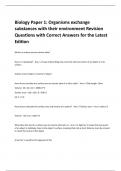
-
Biology Paper 1: Organisms exchange substances with their environment Revision Questions with Correct Answers for the Latest Edition
- Exam (elaborations) • 50 pages • 2024
- Available in package deal
-
- $14.49
- + learn more
What is a surface area to volume ratio? How is it calculated? - AnsA way of describing how close the internal section of an object is to its surface Surface area of object / volume of object How do we calculate the surface area to volume ratio of a 10cm cube? - AnsSide length: 10cm Volume: 10 x 10 x 10 = 1000cm^3 Surface area = (10 x 10) x 6 = 600^2 SA: V = 0.6 How do you calculate the surface area and volume of a sphere? - AnsSurface area - 4 x pi x radius^2 Volume - 4/3 x pi x radiu...
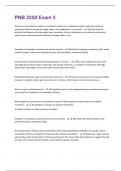
-
PNB 2250 Exam 3 Questions And Answers Latest Updates
- Exam (elaborations) • 27 pages • 2024
- Available in package deal
-
- $7.99
- + learn more
Name an animal that has neither a circulatory system nor a respiratory system and relies solely on cutaneous diffusion for gas exchange. How is this adequate for its survival? - Small and thin animals, like flatworms and horsehair worm parasites, have no respiratory or circulatory systems and solely rely on cutaneous/cuticle diffusion through water or air. Examples of respiratory structures of aquatic animals - bulk flow (sponges, cnidarians), gills, water vascular system, arborescent respi...
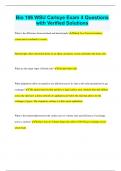
-
Bio 106 WSU Carloye Exam 4 Questions with Verified Solutions
- Exam (elaborations) • 11 pages • 2024
- Available in package deal
-
- $9.99
- + learn more
Bio 106 WSU Carloye Exam 4 Questions with Verified Solutions What is the difference between blood and hemolymph? Blood: In a Closed circulatory system and is confined to vessels. Hemolymph (AKA interstitial fluid): In an Open circulatory system and bathes the body cells. What are the major types of blood cells? red and white cells What adaptations allow an animal to use diffusion across its skin as the only mechanism for gas exchange? The animal must be thin and have a large sur...
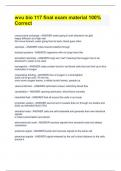
-
wvu bio 117 final exam material 100% Correct
- Exam (elaborations) • 5 pages • 2024
- Available in package deal
-
- $9.99
- + learn more
crosscurrent exchange - ANSWER water going in both directions for gills keeps diffusion at a high rate fish move forward, water going front to back, blood goes other spiracles - ANSWER holes insects breathe through tracheal systems - ANSWER organisms with no lungs have this terrestrial mammals - ANSWER lungs are "wet" meaning that oxygen has to be dissolved in water to be used hemoglobin - ANSWER major protein found in red blood cells that can bind up to four molecules of oxygen
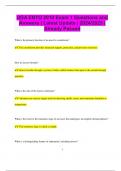
-
UGA ENTO 2010 Exam 1 Questions and Answers | Latest Update | 2024/2025 | Already Passed
- Exam (elaborations) • 25 pages • 2024
-
- $9.78
- + learn more
UGA ENTO 2010 Exam 1 Questions and Answers | Latest Update | 2024/2025 | Already Passed What is the primary function of an insect's exoskeleton? The exoskeleton provides structural support, protection, and prevents water loss. How do insects breathe? Insects breathe through a system of tubes called tracheae that open to the outside through spiracles. What is the role of the insect’s antennae? Antennae are sensory organs used for detecting smells, tastes, and sometimes ...

-
BIO 106 WSU Carloye Exam 4 Questions with 100% Correct Answers | Latest Version 2024 | Verified
- Exam (elaborations) • 6 pages • 2024
- Available in package deal
-
- $7.99
- + learn more
What is the difference between blood and hemolymph? - Blood: In a Closed circulatory system and is confined to vessels. Hemolymph (AKA interstitial fluid): In an Open circulatory system and bathes the body cells. What are the major types of blood cells? - red and white cells What adaptations allow an animal to use diffusion across its skin as the only mechanism for gas exchange? - The animal must be thin and have a large surface area. Animals that only diffuse across the skin have a dense ...

-
2024 aqa as biology 7401/2 paper 2 with 350 questions and correct detailed answers (verified answers) |already graded a+|| brand new!!
- Exam (elaborations) • 87 pages • 2024
-
- $14.49
- + learn more
2024 aqa as biology 7401/2 paper 2 with 350 questions and correct detailed answers (verified answers) |already graded a+|| brand new!! What are the advantages of multi-cellular organisms?- ANSWER--able to move -able to hunt(likely to he in top if food chain) -able to adapt to environment -specialised body reigons -able to find a mate What are the disadvantages of multi-cellular organisms?- ANSWER-As they get bigger diffusion is less efficient and specialised exchange surfaces are nee...
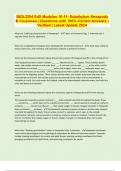
-
BIOL2204 EdX Modules 10-11: Subphylum Hexapoda & Crustacea | Questions with 100% Correct Answers | Verified | Latest Update 2024
- Exam (elaborations) • 6 pages • 2024
- Available in package deal
-
- $8.49
- + learn more
What are 3 defining characteristics of Hexapoda? - 3 pairs of uniramous legs, 1 antennae pair, 3 tagmata (head, thorax, abdomen) What are 2 adaptations Hexapoda have developed for terrestrial existence? - A hard waxy cuticle to reduce water loss, and excretory and respiratory systems to preserve moisture. Write out the following statement about the excretory system of Hexapoda and fill in the missing terms: The Hexapoda excretory system contains ___ ___ attached to the ___ system. These tub...
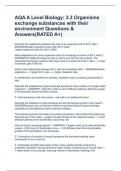
-
AQA A Level Biology: 3.3 Organisms exchange substances with their environment Questions & Answers(RATED A+)
- Exam (elaborations) • 15 pages • 2024
- Available in package deal
-
- $12.99
- + learn more
Describe the relationship between the size of an organism and its SA:V ratio - ANSWERSmaller organisms have high SA:V ratios Larger organisms have low SA:V ratios What adaptations do some organisms have for exchange (in terms of SA:V ratio)? - ANSWERThe flattened shape so that no cell is ever far from the surface. The specialised exchange surfaces with large areas to increase the SA:V ratio ---> lungs in animals, gills in fish etc. What is the relationship between SA:V ratio and metabo...
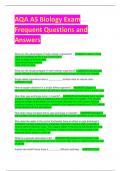
-
AQA AS Biology Exam Frequent Questions and Answers
- Exam (elaborations) • 22 pages • 2023
-
- $9.99
- + learn more
AQA AS Biology Exam Frequent Questions and Answers What are the advantages of multi-cellular organisms? - ANSWER -able to move -able to hunt(likely to he in top if food chain) -able to adapt to environment -specialised body reigons -able to find a mate What are the disadvantages of multi-cellular organisms? - ANSWER As they get bigger diffusion is less efficient and specialised exchange surfaces are needed Single felled organisms have a __________ surface area to volume ratio - ...

Do you wonder why so many students wear nice clothes, have money to spare and enjoy tons of free time? Well, they sell on Stuvia! Imagine your study notes being downloaded a dozen times for $15 each. Every. Single. Day. Discover all about earning on Stuvia


